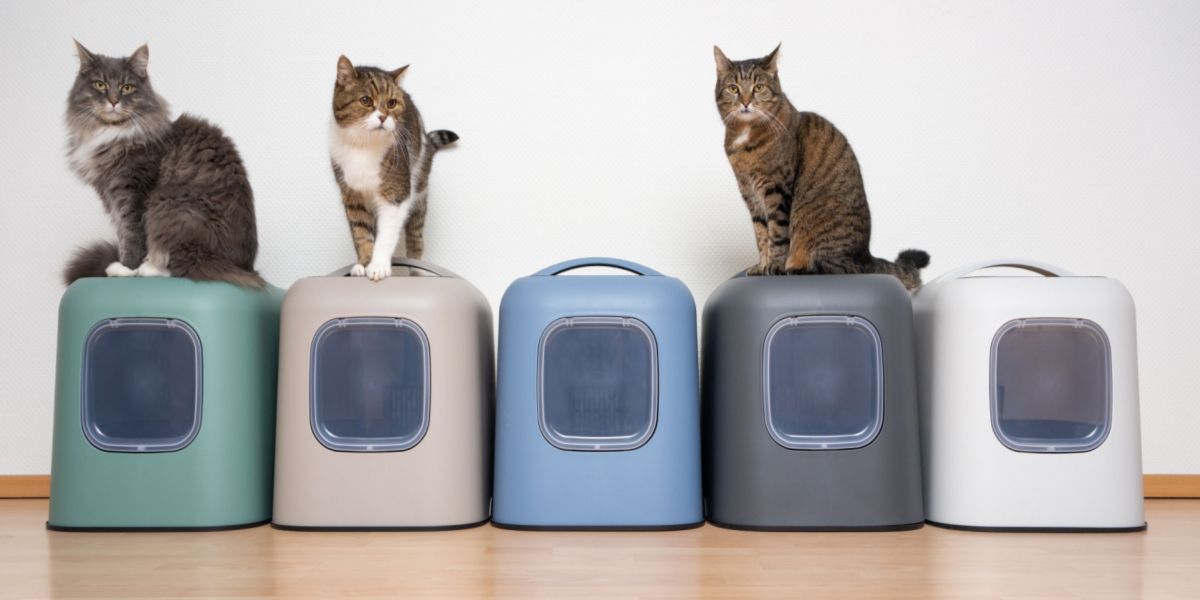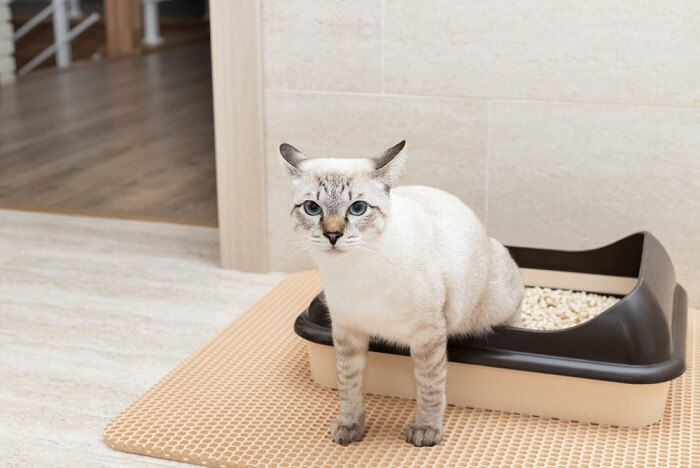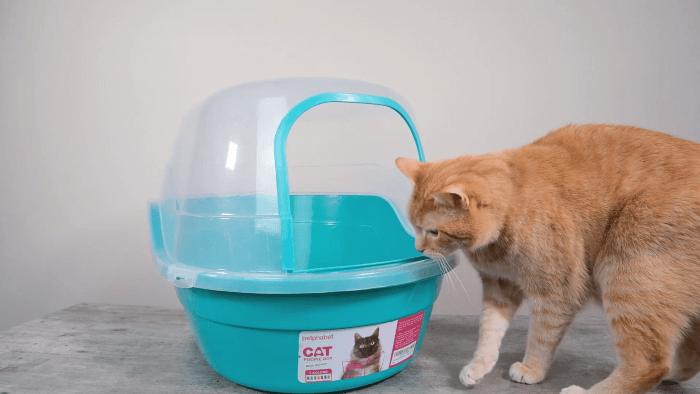
Even if a cat has unrestricted access to the outdoors, it’s best to keep litter boxes indoors in case your cat doesn’t feel safe toileting outside or struggles to make it to the backyard fast enough due to old age or mobility problems.
You can never have enough litter boxes if you’re a cat, so let’s examine the proper number of litter trays per household, including the ins and outs of litter boxes.
| Number of Cats | Recommended Number of Litter Boxes |
|---|---|
| 1 | 1 |
| 2 | 2-3 |
| 3 | 3-4 |
| 4 | 4-6 |
| 5 | 5-7 |
How Many Litter Boxes Do Cats Need?
In multi-cat households, there’s always a need to provide sufficient resources like feeding stations, cat trees, and beds to avoid conflict and reduce competition, and the identical advice applies to litter trays.
The consensus of feline behaviorists is you should have one litter box per cat, plus one more box. Litter boxes should be placed in multiple locations around your home.
Cats who toilet outdoors, generally prefer to urinate and defecate in separate locations. To imitate the ideal litter facilities indoors, you can provide two trays per cat.
Determining How Many Litter Boxes You Need
To determine the number of litter boxes you need, count the number of cats in the household, then add one more. For example, if you have two cats, the minimum number of trays is three. If you have three cats, then the minimum number is four. It never hurts to keep more litter boxes, so don’t hesitate to keep two boxes per cat if you have the space.
If you reside in a small dwelling with several cats, the compromise is to identify the number of social groups of cats and how well they get along. If you have cohesive groups, you can try one litter box per social group plus one extra.
Tips for Litter Box Success

Providing ideal litter box setups can help ensure cats use the boxes consistently.
Regardless of the large variety of litter box products on the market, from a cat’s point of view, the litter box just needs to feel safe, be clean, and be filled with two to three inches of a sand-like substrate to bury and conceal their physical waste.
In order to find out which litter substrate your cat likes, conduct a litter preference test by providing a set of trays containing diverse litter material. If you have a new cat, keep using the same litter they used before (if you know what it was).
Litter box size is very important. The rule of thumb is the box should be at least 1.5 times the length of the cat from the nose to end of the tail. The box should be sturdy and wide enough for your cat to turn around fully, dig, and cover their waste without any constraint. Kittens can start with a small tray, however as they grow up, upgrade their litter box to a bigger size.
Scoop the litter boxes multiple times a day, and completely clean them at least once a week. Cats are more likely to consistently use the boxes when they are kept clean.
Lastly, if your cat is elderly or struggles to climb in or out of the litter box, then supply a large tray with a shallow rim to minimize discomfort.
Where To Place Litter Boxes
Place litter boxes in secluded areas or quiet corners away from heavy foot traffic, and ensure cats have visibility of their surroundings with the safety of a wall or sturdy object behind.
If the cat lives in a multi-story home, place a litter box on each floor preferably, especially if you have a kitten or an elderly cat, to minimize house-soiling accidents. If your cat lives with a dog that tends to invade the litter tray, place the litter boxes in a room protected by a baby gate or install a microchip cat flap within the door.
Do not place litter boxes close to busy thoroughfares, cat flaps that lead outdoors, glass windows, or home entry and exit points so the cat doesn’t get disturbed or feel vulnerable while toileting. Equally, keep litter trays far from food plus water stations and away from any loud noises or vibrations produced by washing machines, dryers, and dishwashers.
Can You Put Litter Boxes Side by Side?
Do not place litter boxes side by side, particularly in multi-cat households. Ideally, place trays in various parts of the house to minimize felines being cornered, blocked off, or guarded by assertive cats.
What To Do if Your Cats Aren’t Using the Litter Box

Cats won’t use a too-small litter box. Choose boxes at least 1.5 times the length of your cat from nose to tail.
If your cats aren’t using the litter box, try putting out extra litter boxes in new places and consider upgrading to larger boxes. You can also conduct litter preference tests, temporarily restricting access to certain parts of the home during the test.
Experiment with different type litter, try covered or open trays, adjust the depth of the litter, and scoop the waste multiple time per day to see if it makes any difference. Record daily elimination habits in a diary to determine your cat’s preference.
If your cat still refuses to use the litter box, or if the cat begins soiling outside the box, take your cat to the veterinarian for a medical checkup. Mention any behavioral changes to your vet, regardless of how subtle they are.
Conclusion
It’s vital to provide enough litter boxes to ensure cats feel comfortable toileting. Creating the idea litter box setup in your home can decrease or completely eliminate accidents outside the box.
Also Read: The 5 Best Automatic Self Cleaning Litter Boxes
Frequently Asked Questions
Should you have a litter box for each cat?
Yes, you need to have one litter box for each cat, plus one more, placed in multiple locations around the house away from noisy or busy areas.
Can I put two litter boxes next to each other?
Don’t group two litter boxes together. Your cat views two boxes close to each other as one giant sandpit. Also, if one box is dirty it's possible they won’t use the other one.
Why do two cats need three litter boxes?
Two cats need three litter boxes so each cat can use a separate tray to pee and poop. If two trays are full of waste, the cats will have access to a clean tray. A third box positioned in a quiet corner can ensure privacy and prevent territorial dispute by pushy cats.
How many litter boxes for 3,4,5 or even 6 cats?
It's recommended that every Two cats use one additional litter boxes so each cat can use a separate tray to pee and poop, therefor 3 cats would require 4 boxes and 6 cats would need 7 litter box. However it's not realistic for most houses to place that litter boxes, so in that case you can multiple larger litter boxes that cats can share.
-
Care, I. C. (2020, September 01). Advanced Feline Behaviour for Vet Professionals Module 8 Clinical Animal Behaviour Part 1. UK. Retrieved August 05, 2022
-
McGowan, R. T., Ellis, J. J., Bensky, M. K., & Martin, F. (2017). The ins and outs of the litter box: A detailed ethogram of cat elimination behavior in two contrasting environments. Applied Animal Behaviour Science.
-
Care, I. C. (2020, September 01). Module 5 Creating a Cat Friendly Home. International Cat Care Advanced Feline Behaviour for Vet Professionals. UK. Retrieved August 02, 2022
-
Halls, V. (2013). To pee or not to pee, finding the litter trays of your dreams. UK. Retrieved August 01, 2022








Does the multiple litter box rule hold true for automatic litter boxes. I have 3 cats. Thanks.
Hi Tobi
Three cats should have at least 3-4 trays, one auto litter box, and 2-3 trays.
I hope that helps answer your question.
Melina
Utter nonsense. We have 5 siamese and one large litter box bought from b&q clear plastic with high sides. Not a regular litter box
I have 4 cats and 3 litter boxes. They are all in a row in one room. I scoop and vacuum 2 times a day. It works for me. My cats never have had a problem with my set up.
Thank you for reading our article and sharing your litter box set-up.
Have a wonderful week.
Melina
Please can you help me?
I need an answer to my query.
Comment:
My cat had GI lymphoma. Had chemotherapy and was cleared of cancer 5
weeks later.
In the 6th week after he was cleared of cancer his blood showed
clumping of blood cells. The VET said this was normal.
“We found that cells moving collectively are more likely to become
Cancer Stem Cells and thus are the primary “villains” of metastasis –
the spread of cancer to different organs. This occurs because the
mechanism by which cancer cells decide to move collectively also
triggers the mechanism which converts it into stem cells, but if
cancer cells decide to move individually, their mechanism to gain
properties of stem cells can be shut down. Therefore, cells moving in
a cluster in the bloodstream pose a much higher risk of starting a new
tumour at a distant organ than those moving individually.”
He died a few weeks later as the cancer has spread to other parts of
his body but not due to GI lymphoma.
The clumping of blood cells must have allowed the cancer to spread?
Thanks
Sue
Hi Sue
I am sorry to hear about your cat’s GI lymphoma.
One of our veterinarians will respond soon.
We are sending you both love & healing.
Melina
Hi Sue,
I’m very sorry to hear about your cat.
Thanks for reaching out to us with your question.
It’s true that clumps of cells, usually originating from the tumor blood supply, are more likely to spread cancer that single cells travelling through the bloodstream.
Was it platelets that were clumped on your cat’s blood sample? If so, it’s very common for platelets to be clumped on a normal blood sample. Platelets are responsible for coagulation and they tend to stick together in clumps, this often happens during blood collection or after blood collection while the sample is waiting to be tested, not before sampling. This may mean that your cat’s cells weren’t clumping and that it just occurred during the sampling procedure, if the clumping cells were platelets.
It’s hard to know for sure in your cat’s case as I don’t have the full details, but platelet clumping regularly occurs during blood sampling in cats. If you have any more details about the blood test, feel free to let me know and I’ll try to help if possible.
All the best,
Aisling
One of our two male cats always urinates outside of a litter box ( within two feet ) . We have a total of three litter boxes ( one upstairs and two downstairs ). He always defecates inside the box. Any suggestions ? – Tom
Hi Thomas
Thank you for reading our article and your comment.
Has a veterinarian checked your male cat?
Pain and medical issues cause many house soiling issues. Feline idiopathic cystitis (Feline Interstitial Cystitis) is the most common cause of FLUTD and urination outside the box: https://cats.com/feline-idiopathic-cystitis.
It would be a good idea to consult your veterinarian to figure out any medical causes before proceeding to a behavioral evaluation, since it’s been ongoing for a long time.
Once you get the medical ok, it’s worth asking for a referral to a veterinary or cat behaviorist in your area.
Meanwhile, try changing the litter boxes (get a larger size) and try a different litter type. Also watch for any guarding of the litter box by the second cat.
I hope this helps.
Melina